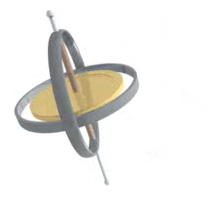The Earth’s axis of rotation wobbles slowly and periodically over time in a process known as precession. Precession is the third orbital parameter that Milankovitch claimed would affect insolation values for the Earth.
Precession would affect climate because a change in the direction of the Earth’s axis of rotation would result in changes in the location and duration of the seasons. The northern hemisphere experiences winter when the Earth’s axis points away from the sun, and summer when the Earth’s axis points toward the sun (the seasons are reversed in the southern hemisphere). Currently, winter in the northern hemisphere occurs roughly during the months of December, January, and February. As a result of precession, however, this situation will have reversed itself in approximately 13,000 years. Winter will instead occur in June, July, and August because this is when the Earth’s axis will be pointing away from the sun. The Earth will also be at its most distant point from the sun in its orbit during these months. Together these two factors would result in more extreme winters and a gradual build-up of snow and ice over time.
The three orbital cycles that Milankovitch identified (eccentricity, obliquity, and precession) are today together known as Milankovitch cycles. Scientists today are in general agreement that the Milankovitch cycles are a major factor in the formation of ice ages. Other feedback mechanisms on the Earth, however, are also believed to contribute to the emergence of ice ages.
Looking at Precession
The projection of the Earth’s axis of rotation on the night sky is known as the North Celestial Pole in the northern hemisphere. The star closest to the North Celestial Pole is known as the pole star. Currently this star is Polaris (also known as the North Star).
Play the animation below to view how the constellations appear to rotate around the stationary North Celestial Pole. Also, pay particular attention to the motion of Polaris (i.e. the North Star). (Note: This animation takes place over the course of a few months.)
- Do the constellations really rotate around the North Celestial Pole? Explain. The constellations do not really rotate around the North Celestial Pole; they only appear to do so. In reality, of course, it is actually the Earth that is rotating around the fixed point of the North Celestial Pole. We consider the Earth to be stationary from our perspective, so it appears that the constellations are instead rotating around Earth’s axis of rotation.
- Is Polaris in exactly the same location as the North Celestial Pole? Polaris is not exactly in the same location as the North Celestial Pole, but it is very close. It is, in fact, close enough that it can be accurately used for navigation purposes (i.e. the direction north can be determined by locating Polaris).
Play the animation below to view how the North Celestial Pole changes location as a result of precession. (Note: This animation takes place over the course of thousands of years.)
Run the animation above again, but this time stop the animation each time the North Celestial Pole approaches the indicated star (i.e. the new pole star) listed in the following table. Once the animation has been stopped, read the appropriate date for this configuration, as well as relevant background information in the table below. The animation starts with Polaris as the pole star (i.e. the current configuration) in the year 2000.
| Pole Star | Year (in common era) | Notes |
| Polaris | 2000 | The current pole star (i.e. the North Star). |
| Er Rai | 4000 | Er Rai will be the next pole star after Polaris. Er Rai is located 45 light years from Earth and is actually a double star system. |
| Alderamin | 7500 | Alderamin has an extremely high rotational speed taking only 12 hours to complete one revolution (the sun takes about 25 days). It is located 50 light years from Earth. |
| Vega | 13700 | Vega is the fifth brightest star in the night sky and is located 25 light years from Earth. |
| Thuban | 22500 | Thuban was the pole star when the Great Pyramid was built in Egypt around 2560 BCE. It is located 303 light years from Earth. |
| Polaris | 28000 | Polaris again becomes the pole star. |
- How long does it take the Earth to complete one precession cycle? The animation starts with Polaris as the pole star in 2000 and ends with Polaris again being the pole star in 28000. The period of the precession cycle is thus 26,000 years (28,000 years – 2,000 years = 26,000 years).




